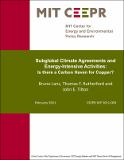| dc.contributor.author | Lanz, Bruno, 1980- | |
| dc.contributor.author | Rutherford, Thomas Fox | |
| dc.contributor.author | Tilton, John E. | |
| dc.date.accessioned | 2011-10-17T15:27:55Z | |
| dc.date.available | 2011-10-17T15:27:55Z | |
| dc.date.issued | 2011-02 | |
| dc.identifier.other | 2011-003 | |
| dc.identifier.uri | http://hdl.handle.net/1721.1/66272 | |
| dc.description.abstract | Subglobal climate policies induce changes in international competitiveness and favor a
relocation of carbon-emitting activities. We argue that many energy-intensive activities are
also capital-intensive, so that carbon policies could affect rents rather than abatement or
location. Taking copper as an example, we formulate a plant-level spatial equilibrium model
of the industry, and we estimate a set of elasticities to calibrate the behavioral parameters of
the model. Given 2007 market conditions, Monte Carlo simulations suggest that a $50/tCO2
tax in industrialized countries induces emissions reductions of less than one percent in the
copper industry, with a mean emission leakage rate of 25%. Our results conform with empirical
findings on the pollution haven effect but challenge projections from computable general
equilibrium models. | en_US |
| dc.description.sponsorship | Massachusetts Institute of Technology. Center for Energy and Environmental Policy Research | en_US |
| dc.language.iso | en_US | en_US |
| dc.publisher | MIT Center for Energy and Environmental Policy Research | en_US |
| dc.relation.ispartofseries | MIT-CEEPR;2011-003 | |
| dc.rights | An error occurred on the license name. | en |
| dc.rights.uri | An error occurred getting the license - uri. | en |
| dc.title | Subglobal Climate Agreements and Energy-Intensive Activities: Is there a Carbon Haven for Copper? | en_US |
| dc.type | Working Paper | en_US |
